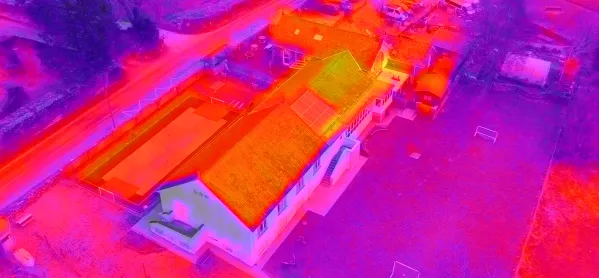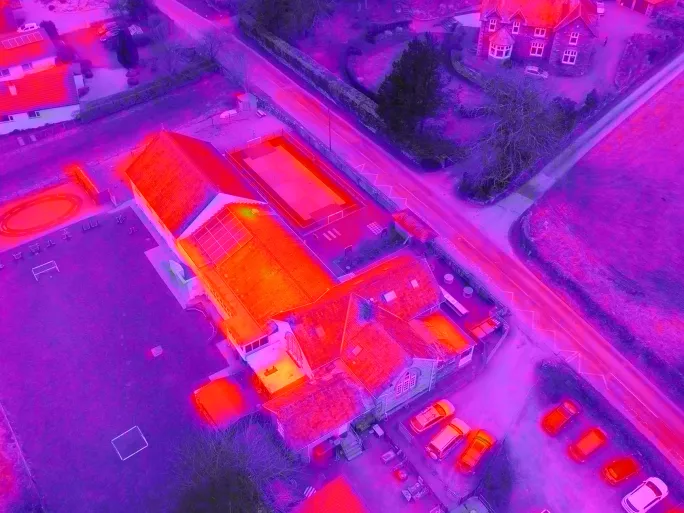- Home
- Leadership
- Finance
- Why we hired a drone to tackle sky-high energy costs
Why we hired a drone to tackle sky-high energy costs

The current financial climate faced by schools - driven especially by rocketing energy bills - means findings savings wherever we can is absolutely vital.
Thankfully, at our school, we have been proactive in this area over the past few years, undertaking and commissioning work such as installing LED lighting throughout school and solar panels - both helping to subsidise our bills.
The staff and children are constantly driven by ways to help save the environment through energy saving, recycling and other measures.
Blue-sky thinking
However, there is always more we can all do - especially as small, rural church schools have buildings that, while lovely to look at, are not very energy efficient, can be quite old and often have very contrasting energy (and in this case heat) usage to more modern ones.
This was why we decided that, in order to further reduce energy use, we needed to identify if and where our buildings are well insulated or if they were leaking “money” through our walls and roofs - an identification made possible by the rise of drone technology.
Of course, you can pick up drones online for a reasonable price these days - but using them for professional purposes like this means you need to call in the experts.
This means ensuring they have the necessary qualifications and licenses from the Civil Aviation Authority, conduct proper risk assessments and have appropriate insurance.
Being situated in the Lake District, we had a local drone company recommended to us that had performed thermal scans and quality checks of roofs, etc, for multiple local hotels and pubs - all of who are trying to save money like we are.
Finding the right firm
The company in question ticked all the boxes - including that they had multiple drones (one that would go 10km from the pilot) - and a particular drone equipped with thermal cameras so we could survey our buildings and spot issues that needed addressing.
They also offered a free lesson and instruction to the children, who are all fascinated with hardware and more aware of technology and its uses than many adults.

The results from the day were notable, with small gaps in our insulation seen that we would otherwise have been unaware of and can now set about trying to rectify.
Problems to solve
Gaps around roofing, windows and even gaps in sealant were all identifiable - all an easy fix, too. One space, in particular, was shown to be poorly insulated, which we didn’t consider previously.
An additional benefit was that we have been able to use video from the drone company to confirm that we have a roof in very good condition - something that has been a concern since Storm Arwen in 2021 but can now be put to rest.
As a headteacher, I am quite often frustrated by the annual checks that our local authority and the Department for Education fund - as they must do.
How a check can comment on things like the roof quality without actually looking is a mystery to me - a quick drone flight does this and is, I suspect, a much better use of money.
The cost of hiring the drone wasn’t cheap (just under £250, including all editing, files and a not-inconsiderable amount of time) but we were able to use funding we had in our delegated budget to cover this.
Findings from the works would also inform how we would use funding that we receive from the additional school capital funding to make further improvements to our energy efficiency in the future.
Teachable moments
Will our drone findings save significant amounts of money? No, not on its own, though I’m confident we will cover costs with savings in the first year and can also use the findings to inform future energy, and cost, saving actions.
What’s more, the use of the drone crew on site as an educational opportunity for our children was also beneficial - awareness of a growing market and route to employment that will only increase in need and quality.
The example of how we are working to save energy and reduce our impact on the climate - and the science behind thermal imaging technology - can also only benefit us all.
On the day of the survey itself, pupils watched everything from our play areas - some watched the screen from up close as the pilot allowed groups nearby, some tried to follow the drones progress in the sky (a challenge!), they all wanted a go at piloting (none got a go) and everyone was amazed at the capabilities and speed of the hardware.
After the flying had finished, the drone pilot showed the children the results on a larger screen, explaining more about how the different infrared bands represent different temperatures of heat loss.
Overall, for us as a school, it was a highly useful exercise in terms of surveying our estate and gaining insights into our energy loss that we would otherwise have been entirely unaware of.
It may not save huge amounts of money overnight, but anything we can do to create long-term efficiencies in our schools that help us reduce energy use for years to come should be looked at seriously.
Matthew Jessop is the headteacher of Crosthwaite Church of England Primary School. He tweets @mejessop
Register with Tes and you can read two free articles every month plus you'll have access to our range of award-winning newsletters.



